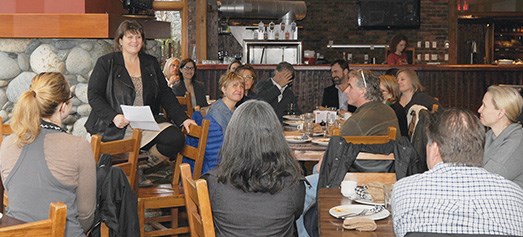Squamish needs creative solutions to its developing housing crisis as the city’s population swells.
Narrow townhouses, secondary suites and carriage homes are a few of the many possible housing solutions that should be considered to create more affordable housing, Mayor Patricia Heintzman told a crowd gathered for the mayor’s breakfast at the Howe Sound Inn on Friday (Feb. 13).
“We need community readiness to tackle this challenge… to make some tough choices of what we need as a community,” she told the group of developers, social agency workers, mortgage brokers and others who came to the breakfast to talk about affordable housing.
“You ask people what size home they grew up in, and it’s usually much smaller than what they have now,” Heintzman noted.
“Do we want to subdivide lots? I am throwing ideas out there that might not be palatable to everyone,” she said, noting that laneways could become second lots. “We need to be strategic.”
Annie De La Chevrotiere, a broker with Garibaldi Mortgage, suggested Squamish needs an affordable housing program similar to Whistler’s.
“That program was designed to attract people to Whistler so they could stay,” she said. “My own sons are looking at housing in Squamish and say, ‘You know, Mom, I don’t think I will ever be able to afford anything here.’”
The mayor said Squamish needs to work in partnership with provincial and federal government entities to find solutions to create affordable housing. The district has also set up an affordable housing taskforce chaired by Councillor Jason Blackman-Wulff.
Ariel Winkelmeyer, a Woodfibre LNG office employee, said she bought a house last year and is now a taxpayer – her comment drew friendly applause. But her concerns were serious: “I support new development for sure, but is the infrastructure in place? Everyone will be affected by that.”
“If you are new to town, we are essentially a bunch of villages that amalgamated when water and sewer pipes got put in…. We’re a sprawled-out city now,” replied the mayor. “Ideally we need to create more taxpayers to pay for those problems you’re talking about.”
Heintzman also noted the need to shed the “cookie-cutter approach to how we see a home” that leads to houses being built on large lots and instead allow for different types of developments, including micro-homes.
Mortgage broker Paul Hudson said the district has done well in the past 10 years “not clamping down on non-conforming suites,” which he said some of his clients need to rent out to offset their large mortgage payments. “If the district will continue to support laneway homes, then it will take some of the pressure off.”
Heintzman noted that transit is an important part of the solution, as the homes with suites cannot accommodate five cars in the driveway, for example. She also said homes need to be built in an energy-efficient way to keep utility bills low and ensure ongoing affordability.
Several developers and other community leaders also spoke at the meeting Friday, which was intended as a way to start the discussion the task force will take forward.
The next mayor’s breakfast, to be held at the Squamish Adventure Centre in March, will focus on the topics of public engagement and participation.
Heintzman emphasized that everyone is welcome at the monthly breakfasts. “There was some talk on social media about why we are charging for a breakfast on affordable housing,” she noted. “If at any time someone doesn’t want to have breakfast, everyone is welcome.”



